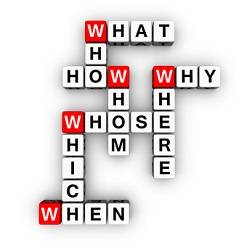Question forms
Question formation in English is different from the formation of other sentences in two main ways. Firstly, the word order is reversed.
You can speak = Can you speak?
He doesn't speak. = Does he speak?
Instead of beginning with the subject, questions begin with a helping verb. Can Does(Information questions begin with a question word like ‘who’ or ‘what’ and then the helping verb.)
The subject comes after the helping verb. You heThe main verb follows the subject, and the rest of the sentence follows it.
Second, questions almost always need a helping verb along with the main verb. (This is also true for negative sentences but not affirmative statements.)
The most common helping verb is 'do.' 'Do' (or 'does' or 'did') doesn't change the meaning of a question but alerts the listener that a question is coming.
Other helping verbs include can, could, should, would, will, have or had, and be (is, are, etc.). We use have or had with the present or past perfect tenses. (Have you seen a doctor about your problem? Had you noticed any dizziness before you fell?)
The verb ‘be’ can be used without a helping verb. It is a helping verb for the continuous tenses, but it can also stand alone. We don’t use the verb ‘do’ together with ‘be,’ except as a negative command: Don't be late!" See the examples below for the usual ways to use 'be.'
The helping verb at the beginning of a question is important for communication. It tells us to listen for a question. So do question words like 'who' 'how.' or 'what.'
In English there are two kinds of questions.
When we are asking for information we begin a question with a ‘Wh-‘ question word.
That means who, what, when, where, why, or how. (Less common Wh- words include whom, which, how many, how much, how long, etc.)
How long is the class?
To whom did you speak?
When we just need a yes or no answer, we omit the question word and begin directly with the helping verb which may be 'do' or 'can'.
Do you understand?
Can you complete the exercise?

Comments
Post a Comment